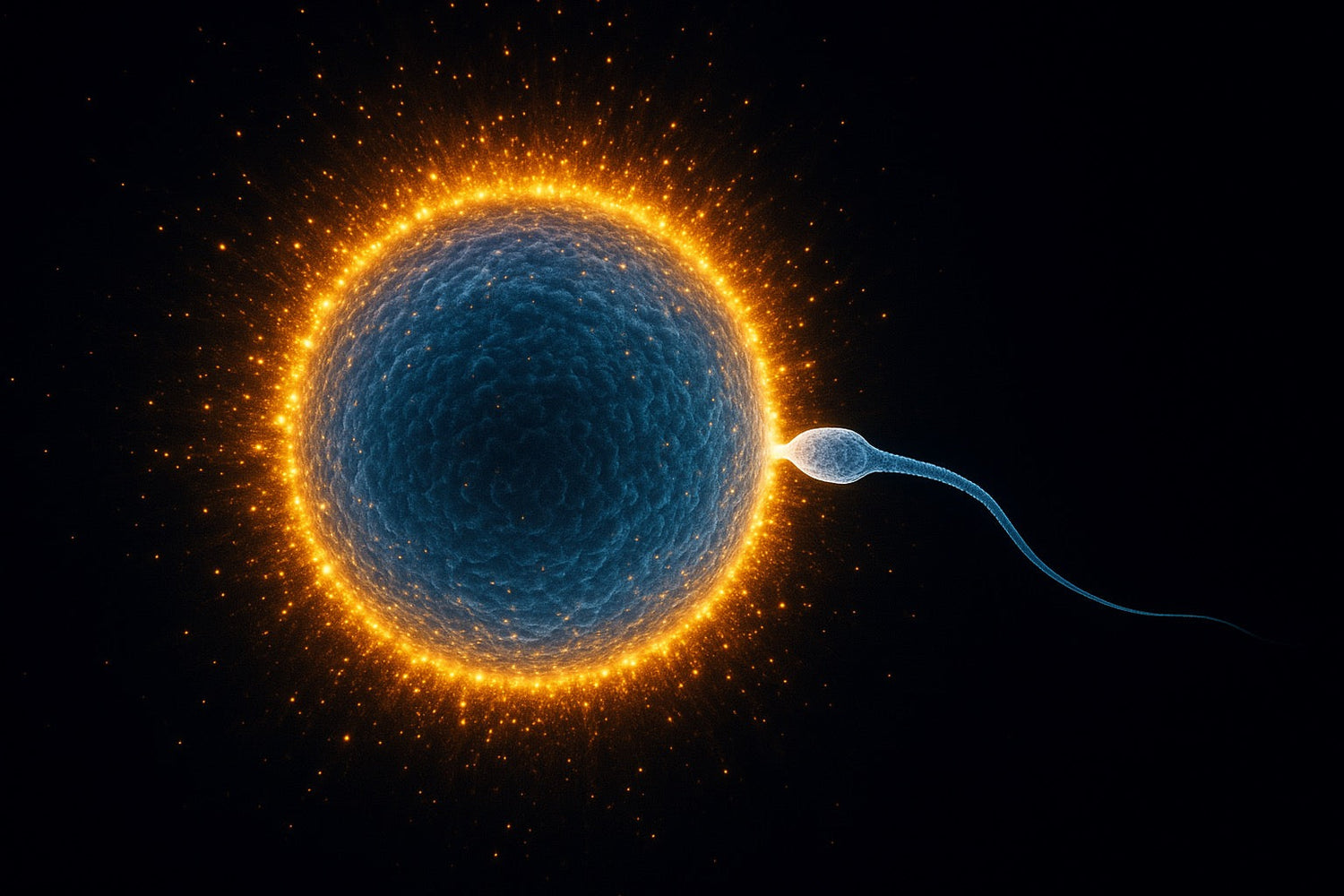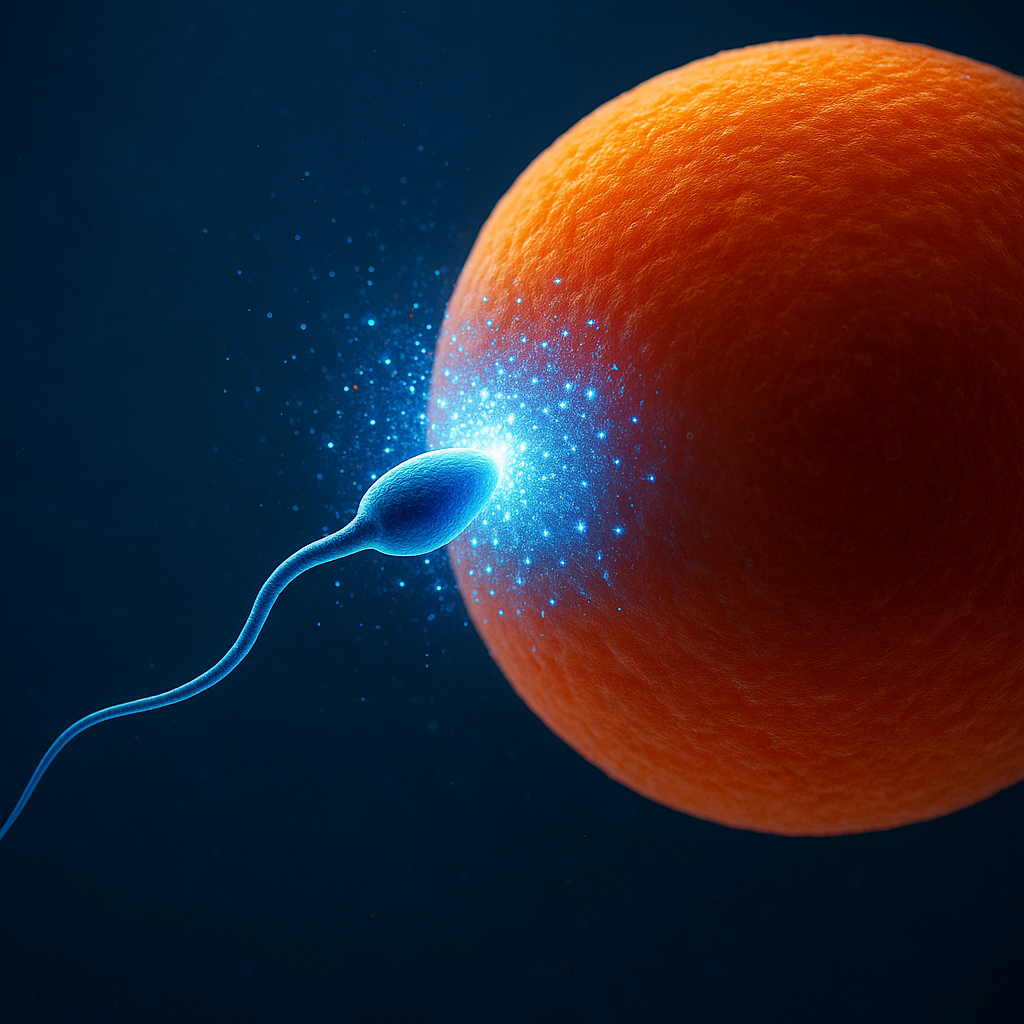The moment sperm meets egg is not just a biological checkpoint. It is the initiation of a profound reversal—a cell suspended in its most adult state, suddenly rewound into the youngest stem cell on Earth. Fertilization is, at its essence, reverse aging. The docking of IZUMO1 on the sperm with JUNO on the oocyte membrane begins the cascade. From that recognition event, calcium oscillations spread through the egg, rewriting its identity and resetting its biological age.
The Adult Egg in Suspension
The human oocyte at metaphase II is unique. It is not a stem cell; it is a fully differentiated gamete, arrested and waiting. Its chromosomes are condensed, its machinery is paused, and its mitochondria—numbering between one hundred thousand and six hundred thousand—are dense and primed beneath the cortex. This is an adult cell held in suspended animation, a state sustained until the instant of fertilization.
The Oscillations That Awaken
When the sperm fuses with the egg, it delivers phospholipase C zeta (PLCζ), the molecular spark that initiates calcium release. The oocyte’s endoplasmic reticulum responds with waves of calcium, each one propagating across the cell in seconds. What makes fertilization extraordinary is not the rise itself but the rhythm: oscillations that repeat for hours, each pulse layered with meaning.
These oscillations are not noise. They are a code. Early spikes trigger cortical granule exocytosis, hardening the zona pellucida and preventing entry of additional sperm. Sustained pulses accumulate into activation of CaMKII, releasing the cell from metaphase II arrest. Later oscillations synchronize with the zinc spark, when billions of zinc atoms are expelled into the perivitelline space, announcing that the oocyte has become a zygote.
Mitochondria as the Power and the Memory
The calcium program could not run without the mitochondria. Human eggs carry more mitochondria than any other cell type, clustered around the spindle and beneath the cortex where calcium release originates. They buffer each surge, fuel the SERCA pumps that reset the endoplasmic reticulum, and provide ATP for exocytosis and cell cycle progression. Their density is not accidental—it is the foundation for sustaining hours of rhythmic signaling. If the egg is healthy, its hundreds of thousands of mitochondria ensure that the oscillations do not falter.
Reverse Aging in Real Time
What these oscillations accomplish is nothing short of remarkable. The oocyte, an adult cell, is stripped of its arrest and reprogrammed into a totipotent stem cell. With each calcium wave, it is driven backwards—out of specialization, out of suspension—into a state of total potential. This is the biological origin of youth. An old cell becomes young again, not metaphorically but literally, as the zygote emerges.
From this reset point, the zygote can divide, differentiate, and generate an entire organism. Fertilization is therefore not only conception; it is the most dramatic reversal of aging known to biology.
Lessons for Human Longevity
What nature achieves at conception, longevity researchers are now striving to emulate in adult tissues. Across the world, efforts in epigenetic reprogramming, stem cell biology, and quantum biology are aimed at recapturing the reset of the zygote. Calcium oscillations and the zinc spark provide the original template: how a single cell erases its age, reopens its potential, and begins again.
If we can learn the rules by which the oocyte accomplishes this transformation, we may apply them to our own adult cells—turning back the biological clock without erasing identity, and unlocking the possibility of true cellular rejuvenation.
Zygote Reset vs. Yamanaka Factors
In 2006, Shinya Yamanaka demonstrated that adult fibroblasts could be reprogrammed into induced pluripotent stem cells (iPSCs) using a cocktail of four transcription factors: Oct4, Sox2, Klf4, and c-Myc. This breakthrough showed that cellular age is not fixed; it can be reversed.
Yet Yamanaka factor reprogramming is slow, artificial, and incomplete. It requires weeks in culture and often carries risks of genomic instability or loss of cell identity. In contrast, the zygote accomplishes a total reset in minutes to hours, driven by endogenous signals like calcium oscillations, zinc flux, and global DNA demethylation. Where iPSC reprogramming pushes adult cells back toward pluripotency, fertilization restores the oocyte to totipotency—a state even more fundamental.
For longevity science, the zygote provides the gold standard. It is the only natural example of complete age reversal, one that occurs seamlessly in every healthy conception. Yamanaka factors may be the tools we wield today, but the blueprint is already written in the egg.
Toward the Light Cone
Developmental biologist Michael Levin has proposed that embryos exist within a light cone of causality, a field of information guiding morphogenesis and repair. My own work in Your Spark is Light builds on this idea, showing how quantum mechanics and the zinc spark connect to consciousness. With the recent structural discovery of IZUMO1–JUNO binding, the picture sharpens.
The entanglement of IZUMO and JUNO is not simply a molecular docking—it is the moment of capture, the biological gate where light, or the Higgs field itself, is trapped into matter. This union forms the omnipotential stem cell, the zygote, capable of becoming anything. This is the light cone of the embryo, and this is the origin point of reverse aging: a cell rewritten into pure potential through quantum entanglement, calcium oscillations, and the zinc spark.
References
-
Duncan FE, Que EL, Zhang N, Feinberg EC, O’Halloran TV, Woodruff TK. The zinc spark is an inorganic signature of human egg activation. Sci Rep. 2016;6:24737.
-
Que EL, Duncan FE, Bayer AR, et al. Zinc sparks induce physiochemical changes in the egg zona pellucida that prevent polyspermy. Integr Biol. 2017;9:135–144.
-
Saunders CM, Larman MG, Parrington J, et al. PLCζ: a sperm-specific trigger of Ca²⁺ oscillations in eggs and embryo development. Development. 2002;129:3533–3544.
-
Swann K, Lai FA. PLCζ and the initiation of Ca²⁺ oscillations in fertilizing mammalian eggs. Cell Calcium. 2016;59:139–147.
-
Takahashi K, Yamanaka S. Induction of pluripotent stem cells from mouse embryonic and adult fibroblast cultures by defined factors. Cell. 2006;126(4):663-676.
-
Hunt C. Your Spark is Light: The Quantum Mechanics of Human Creation. For extended discussion of zinc sparks, quantum biology, and the physics of fertilization.
-
Levin M. Morphogenetic fields in embryos and regenerating systems. Development. 2012;139(4):629–643.



Leave a comment
This site is protected by hCaptcha and the hCaptcha Privacy Policy and Terms of Service apply.